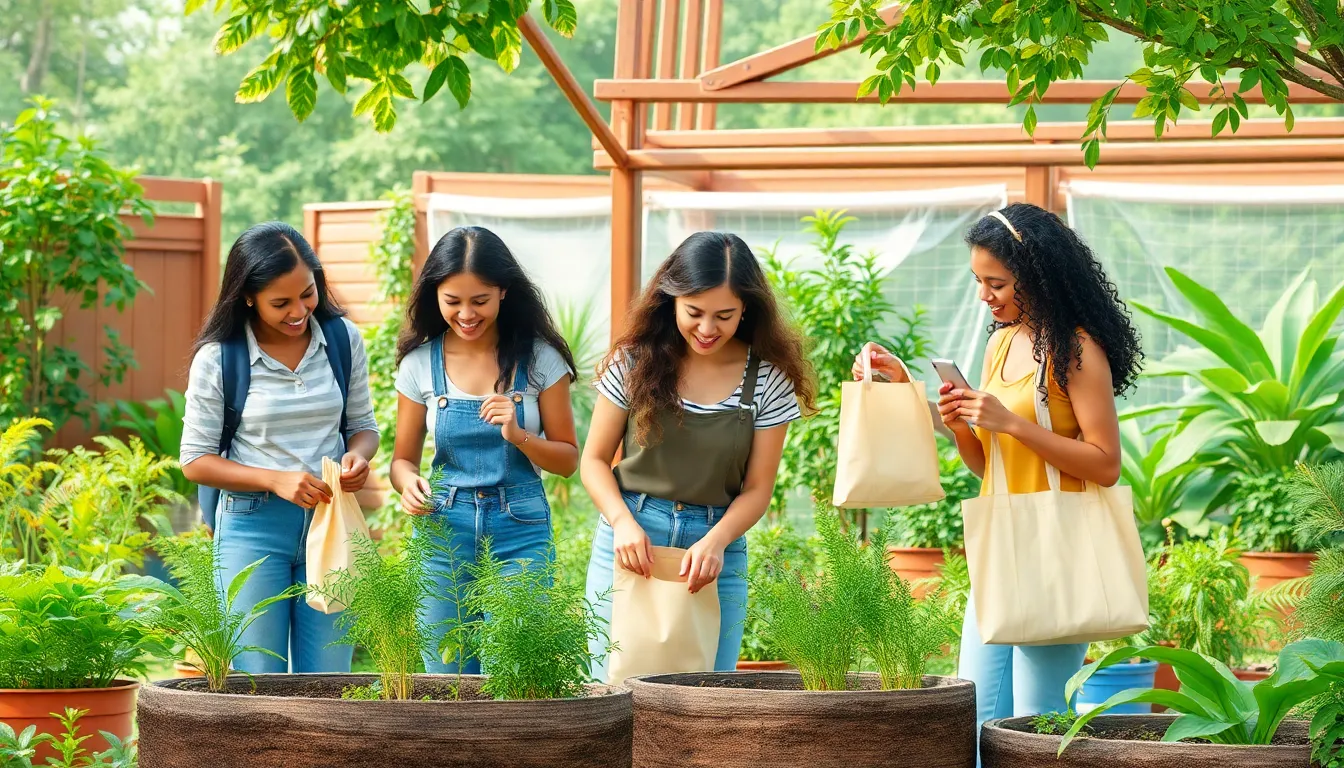Phone:
(701)814-6992
Physical address:
6296 Donnelly Plaza
Ratkeville, Bahamas.

In a world where plastic seems to have its own gravitational pull and single-use items are the life of the party, sustainable living solutions are the unsung heroes we didn’t know we needed. Imagine a lifestyle where you can sip your morning coffee guilt-free, knowing your cup won’t end up in a landfill for the next millennium. It’s not just a dream; it’s a reality waiting for you to embrace.
Sustainable living solutions encompass various practices and products aimed at minimizing environmental impact. These alternatives address the increasing problem of plastic waste and promote conscious consumption. One common solution involves using reusable containers for food and beverages, significantly reducing reliance on single-use plastics.
Adopting energy-efficient appliances contributes to a smaller carbon footprint. Technologies like solar panels generate clean energy, allowing households to decrease utility costs while supporting renewable energy sources. Furthermore, composting organic waste transforms kitchen scraps into valuable fertilizer, enhancing soil quality and reducing landfill contributions.
In addition, choosing sustainable materials for home construction promotes a healthier living environment. Bamboo, reclaimed wood, and recycled materials offer environmentally friendly options for building and furnishing. As people begin to prioritize sustainable fashion, they often seek out brands that utilize eco-conscious practices and materials, reducing textile waste and promoting ethical production.
Transportation methods also affect sustainability. Biking and using public transit lessen emissions, while electric vehicles provide an efficient alternative to gasoline-powered cars. Individuals are encouraged to support local businesses, as they often use fewer resources for shipping and contribute to community economies.
Lastly, water conservation practices remain crucial for sustainable living. Installing low-flow fixtures and collecting rainwater encourages efficient usage while protecting this vital resource. Each of these solutions plays a role in fostering a lifestyle that harmonizes daily needs with environmental stewardship.

Sustainable living offers numerous advantages that enhance both personal well-being and the environment.
Reducing reliance on single-use items significantly cuts down plastic waste, which harms ecosystems. By adopting practices like composting and using reusable containers, individuals contribute to soil health while minimizing landfill overflow. Utilizing energy-efficient appliances and renewable energy sources, such as solar panels, decreases greenhouse gas emissions. Choosing sustainable materials for construction promotes biodiversity, supporting healthier ecosystems. Lastly, opting for low-emission transportation methods lessens air pollution, improving overall community health.
Sustainable living often leads to lower utility bills due to reduced energy and water consumption. Investing in energy-efficient appliances initially saves significant amounts over time. Local food sources typically have shorter supply chains, resulting in fewer transportation costs. Supporting local businesses stimulates community economies, fostering resilience and strengthening relationships. Adopting a sustainable lifestyle can also attract patrons to businesses that embrace eco-friendly practices, enhancing marketability. Overall, sustainable living not only benefits the environment but also promotes personal financial health.
Sustainable living solutions offer impactful alternatives to reduce environmental harm. These practices enhance daily life while promoting ecological responsibility.
Harnessing renewable energy sources significantly reduces reliance on fossil fuels. Solar power provides a clean energy alternative, with many homes adopting solar panels to generate electricity. Wind energy also plays a crucial role, using turbines to convert wind into power. By switching to renewable energy options, households can save on energy costs and contribute to a cleaner planet. Geothermal systems further enhance energy efficiency by utilizing the Earth’s heat. Communities embracing these sustainable technologies enjoy reduced carbon footprints and increased energy independence.
Implementing water conservation techniques is vital for sustainable living. Low-flow fixtures can drastically reduce water usage in bathrooms and kitchens. Collecting rainwater for garden irrigation offers an eco-friendly solution for maintaining landscaping. Additionally, xeriscaping encourages the use of drought-resistant plants, minimizing the need for irrigation. Educating households on practices like fixing leaks represents another effective measure for conserving water. Simple steps enhance resource management and promote ecological balance, ensuring access to clean water for future generations.
Adopting a zero-waste lifestyle promotes minimal waste generation through conscious decisions. Choosing reusable bags, containers, and utensils helps eliminate single-use plastics from everyday life. Composting organic materials reduces landfill contributions, transforming waste into nutrient-rich soil. Shopping secondhand or supporting sustainable brands minimizes resource consumption and encourages responsible production practices. Engaging in community exchange programs fosters local collaboration, driving the zero-waste movement forward. Each of these actions contributes to a cleaner environment and a sustainable future.
Adopting sustainable practices at home significantly reduces environmental impact. Individuals can make tangible changes that promote eco-friendliness.
Upgrading to energy-efficient appliances can decrease electricity consumption and lower utility bills. LED light bulbs use up to 75% less energy than traditional incandescent bulbs. Incorporating smart thermostats allows for precise temperature control, optimizing heating and cooling systems. By sealing drafts and insulating homes, energy loss decreases dramatically. These upgrades enhance comfort while contributing to sustainability goals.
Creating a sustainable garden promotes biodiversity and enhances local ecosystems. Utilizing native plants requires less water and supports local wildlife. Composting kitchen scraps enriches garden soil while reducing landfill waste. Employing rain barrels catches runoff, conserving water for future use. Mulching around plants helps retain moisture and suppress weeds. Each practice contributes to a thriving, eco-friendly habitat at home.
Community participation plays a crucial role in strengthening sustainability efforts. Collaborative projects can lead to significant environmental improvements and foster a sense of shared responsibility.
Local initiatives often inspire residents to engage in sustainability practices. Community gardens promote local food production, enhancing food security while reducing carbon footprints. Clean-up events mobilize volunteers to remove litter from parks and waterways, directly improving local ecosystems. Furthermore, awareness campaigns educate citizens about reducing plastic use and practicing recycling. Local businesses frequently collaborate on sustainable practices, creating a network that supports the community and the planet. Neighborhood workshops teach skills such as composting and energy efficiency improvements, empowering residents to adopt greener habits. These initiatives highlight how collective action can yield tangible benefits for both the environment and the community.
Advocacy for policy changes drives significant progress toward sustainability goals. Community members often unite to support regulation that mandates recycling and waste reduction. Grassroots movements can influence local governments to adopt environmentally friendly policies, impacting broader sustainability initiatives. Engaging with local representatives allows citizens to voice their concerns about environmental issues and propose solutions. Collaborations between organizations facilitate lobbying efforts aimed at sustainable practices, such as renewable energy adoption and conservation policies. These advocacy efforts create a framework for long-term environmental stewardship, ensuring that sustainability remains a priority in local governance.
Embracing sustainable living solutions is more than just a trend; it’s a vital step toward a healthier planet and a more fulfilling life. By making conscious choices in daily activities individuals can significantly reduce their environmental footprint while enjoying the benefits of a sustainable lifestyle.
From utilizing reusable products to supporting local businesses every action counts in creating a positive impact. Community involvement and advocacy play crucial roles in fostering a culture of sustainability that resonates deeply within neighborhoods and beyond.
As more people engage in sustainable practices the collective effort can lead to meaningful change ensuring a greener future for generations to come. It’s time to take action and inspire others to join the movement toward a sustainable way of living.